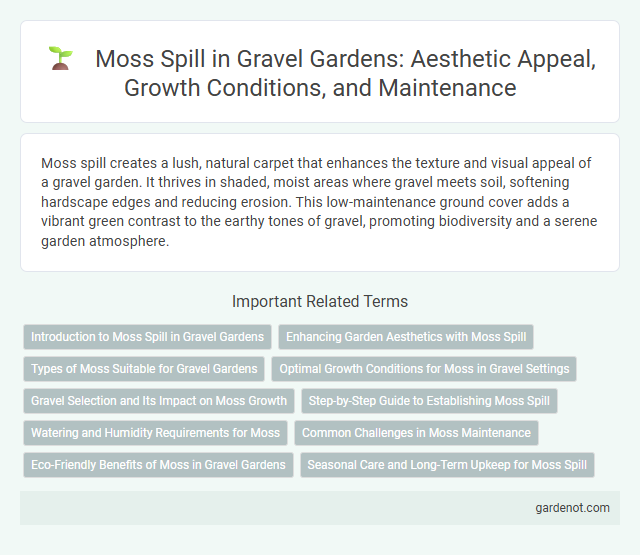Moss spill creates a lush, natural carpet that enhances the texture and visual appeal of a gravel garden. It thrives in shaded, moist areas where gravel meets soil, softening hardscape edges and reducing erosion. This low-maintenance ground cover adds a vibrant green contrast to the earthy tones of gravel, promoting biodiversity and a serene garden atmosphere.
Introduction to Moss Spill in Gravel Gardens
Moss spill in gravel gardens refers to the natural spread of moss over gravel surfaces, creating a soft, green carpet that contrasts with the hard texture of stones. This phenomenon enhances the garden's aesthetic by adding lush, low-maintenance greenery that thrives in shaded, moist conditions common to gravel garden environments. Managing moss spill involves balancing moisture levels and sunlight exposure to maintain its vibrant appearance without overwhelming the gravel layout.
Enhancing Garden Aesthetics with Moss Spill
Moss spill enhances garden aesthetics by creating a lush, green carpet that softens hardscape elements and provides a natural, serene appeal. Its low maintenance and ability to thrive in shaded, moist areas make it ideal for adding texture and depth to gravel gardens. Incorporating moss spill promotes biodiversity by offering habitat for small insects, contributing to a balanced and visually appealing garden ecosystem.
Types of Moss Suitable for Gravel Gardens
Silky fork moss (Dicranum scoparium), with its dense and cushiony texture, thrives in gravel gardens by retaining moisture and providing year-round greenery. Haircap moss (Polytrichum commune) is ideal for gravel settings due to its upright growth habit and tolerance to dry, sunny conditions. Cushion moss (Leucobryum glaucum) creates lush, soft mounds that complement gravel surfaces while stabilizing soil and minimizing erosion.
Optimal Growth Conditions for Moss in Gravel Settings
Moss spill thrives in shaded, moist environments with porous gravel that retains humidity without waterlogging roots. Maintaining a slightly acidic soil pH between 5.0 and 6.5 optimizes nutrient availability for moss growth in gravel gardens. Regular misting and minimal foot traffic support lush, evenly spread moss coverage in gravel settings.
Gravel Selection and Its Impact on Moss Growth
Choosing the right gravel is crucial for promoting healthy moss growth in a gravel garden, as the size, texture, and color of the gravel influence moisture retention and light absorption. Smaller, rough-textured gravel with muted earth tones enhances moisture levels and provides a favorable surface for moss spores to anchor and thrive. Selecting gravel that balances drainage with sufficient water retention creates an ideal microenvironment, encouraging dense and vibrant moss spill coverage.
Step-by-Step Guide to Establishing Moss Spill
Establishing a moss spill in a gravel garden requires preparing a smooth, shaded substrate where moss spores can easily attach and grow. Begin by clearing the area of debris and lightly moistening the gravel surface to create ideal humidity levels for moss establishment. Regularly mist the area and monitor moisture retention to encourage dense moss growth, ensuring a lush, green spill that complements the gravel garden's natural aesthetic.
Watering and Humidity Requirements for Moss
Moss spill thrives in consistently moist environments with high humidity levels, requiring regular watering to maintain damp soil without waterlogging. Ideal watering involves gentle misting or slow, deep watering to ensure moisture penetrates the substrate, promoting healthy growth and preventing browning. Maintaining a shaded or partially shaded location helps retain humidity, reducing evaporation and supporting the moss's delicate hydration balance.
Common Challenges in Moss Maintenance
Moss spill in gravel gardens often leads to uneven coverage and patchy growth due to fluctuations in moisture levels and sunlight exposure. Common challenges include controlling invasive weed species that disrupt moss development and managing soil acidity to maintain optimal conditions for moss proliferation. Regular monitoring and gentle cleaning techniques are essential to prevent damage while promoting healthy moss expansion.
Eco-Friendly Benefits of Moss in Gravel Gardens
Moss spill in gravel gardens enhances biodiversity by providing a natural habitat for microfauna and promoting soil moisture retention. Its low-maintenance growth reduces water usage and eliminates the need for chemical fertilizers or pesticides, supporting sustainable gardening practices. By improving air quality and preventing soil erosion, moss contributes significantly to an eco-friendly gravel garden ecosystem.
Seasonal Care and Long-Term Upkeep for Moss Spill
Moss spill thrives in damp, shaded gravel garden areas requiring minimal seasonal intervention, where regular misting during dry spells promotes healthy growth and prevents desiccation. Long-term upkeep involves removing debris and controlling foot traffic to preserve moss integrity while avoiding soil compaction that impedes moisture retention. Applying a thin layer of acidified water or moss-specific fertilizer annually supports sustained vitality and vibrant color.
Moss spill Infographic

 gardenot.com
gardenot.com